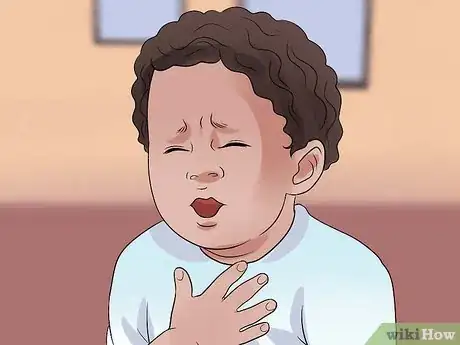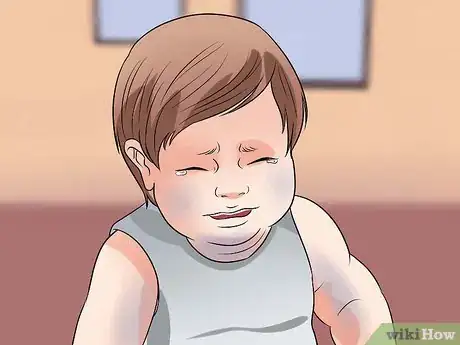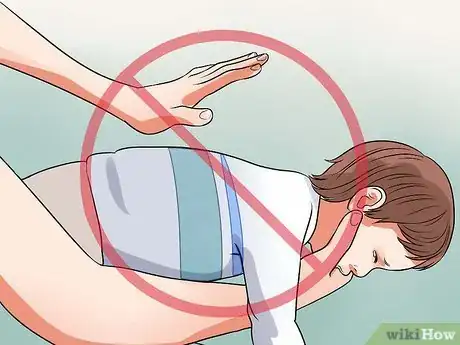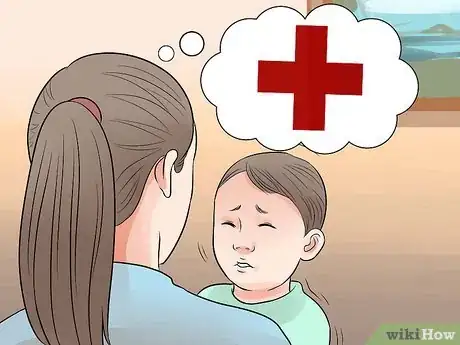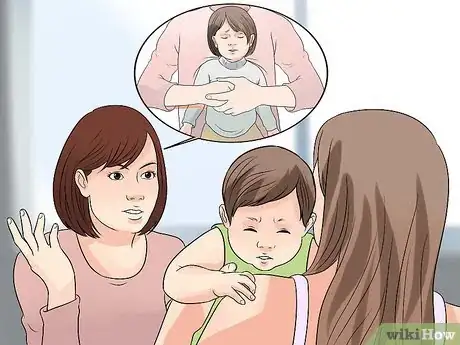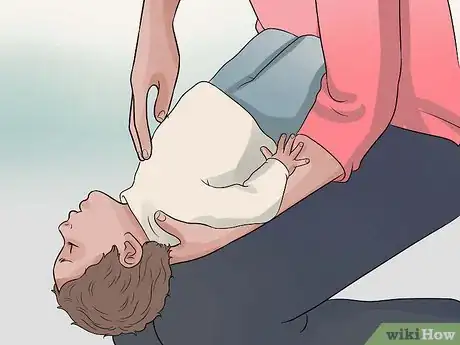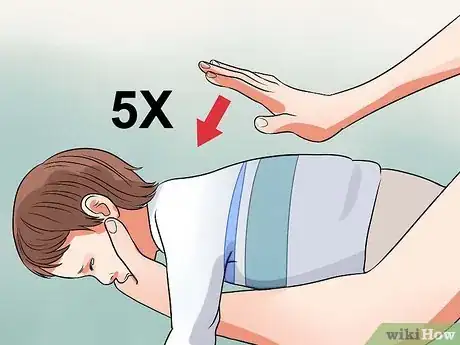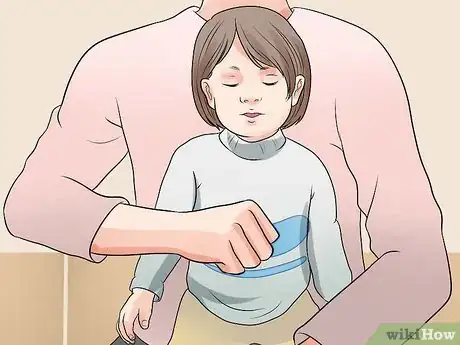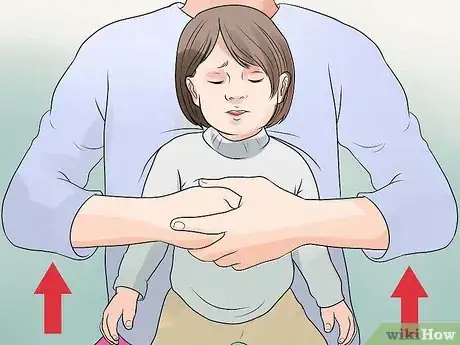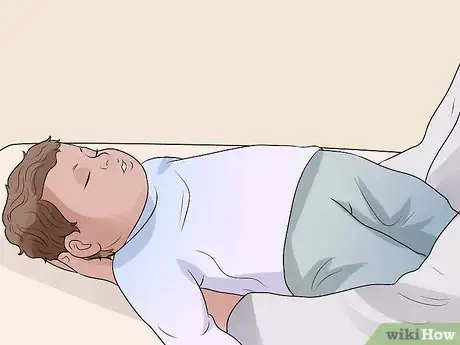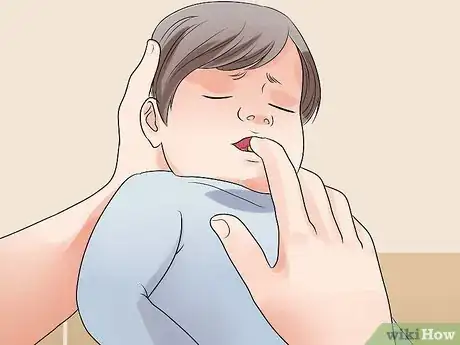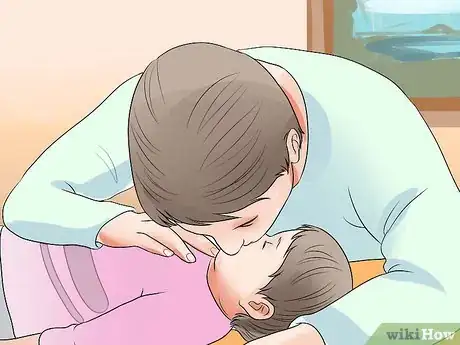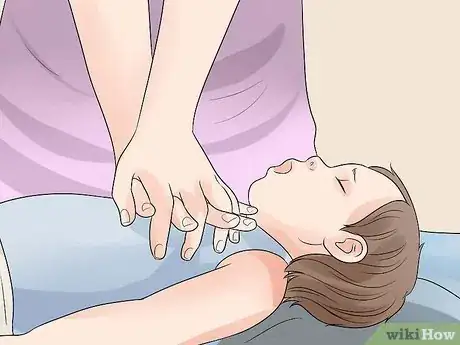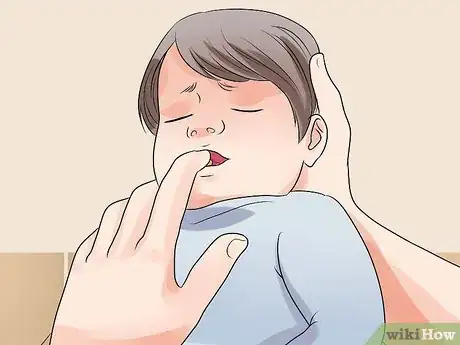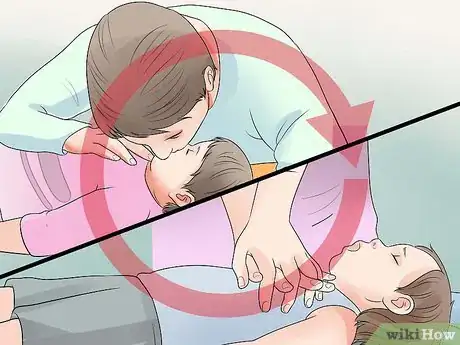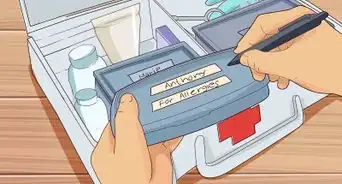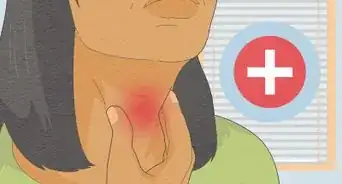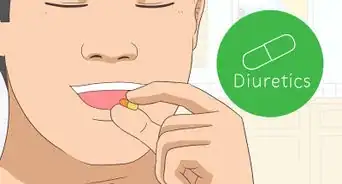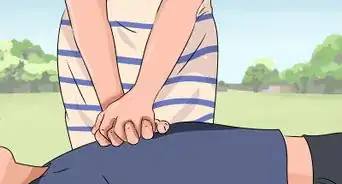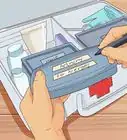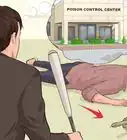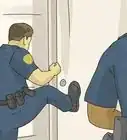This article was medically reviewed by Erik Kramer, DO, MPH. Dr. Erik Kramer is a Board-Certified Primary Care Physician at the University of Colorado. With over 15 years of experience, his clinical interests include obesity and weight management, diabetes care, and preventive care, as well as embracing a holistic approach to primary care. He received his Doctorate in Osteopathic Medicine (D.O.) from the Touro University Nevada College of Osteopathic Medicine and completed his residency at Central Maine Medical Center. Dr. Kramer is a Diplomate of the American Board of Obesity Medicine.
There are 7 references cited in this article, which can be found at the bottom of the page.
This article has been viewed 245,741 times.
It's common for toddlers to put items and food in their mouths. Sometimes, this tendency can cause a toddler to choke. Children can lose consciousness quickly, so it's important to know how to effectively clear the airway by performing the Heimlich maneuver. If the Heimlich maneuver fails to dislodge the item obstructing the airway and the child becomes unconscious, you'll need to move on to CPR.
Steps
Assessment
-
1See if the toddler can speak. When someone is choking, they'll lose the ability to speak because air can't get through. Therefore, if you ask the toddler a question and they can't reply, they may be choking.[1]
- The toddler might also grab at their throat if they are choking.
-
2Look to see if the toddler is having trouble breathing. You may notice that they’re having trouble drawing breaths. They may also be making weird noises when they’re breathing.[2] For example, they might make a high-pitched noise when drawing in a breath.[3]Advertisement
-
3Check for weak coughing. The toddler may be trying to cough up what's in their throat and failing. Therefore, the cough will be weak. A heavy cough likely indicates that enough air is getting through that they’re not choking.[4]
-
4Keep an eye out for blue tinges. Toddlers who aren't breathing may start turning blue around the edges. For instance, you may notice bluish or dusky tinges on their fingernails, lips, or skin.[5]
- However, be aware that children and toddlers compensate for a lack of oxygen better than adults and may not turn blue as fast as an adult would.
-
5Avoid intervening if the child is able to speak. If the child is able to speak or breathe well, don't start the Heimlich maneuver. The same goes if the child is able to cough hard. However, keep watching to make sure the symptoms don't suddenly worsen.[6]
-
6Make sure the toddler is conscious. Choking can cause a toddler to pass out. See if they can look at you when you talk by asking them a question or saying their name. You'll likely need this information when you call 911 or your local emergency number.[7] You'll also need to move on to the steps for an unconscious choking toddler if they’re not conscious.
- You can also lightly flick the bottom of a toddler's foot to check for consciousness.
-
7Ask someone to call emergency services. If you are not alone with the child, ask someone to call 911 or your local emergency number. If you are alone, try the Heimlich maneuver before calling 911. [8]
-
8Get consent from a parent before trying the Heimlich maneuver. If the choking toddler isn’t your child, try to get consent before you attempt a rescue if possible. If a parent is present, quickly ask for consent. But remember, seconds count when saving a life! If nobody is around to ask, don’t wait.
- If you live in the U.S., Good Samaritan laws in your state should cover any action you take in good faith to save the child's life.
The Heimlich Maneuver
-
1Bend the child over at the waist. Have the child bend over at the waist. Place your hand under their chest for support.
- To perform this maneuver properly on a child, you'll likely need to kneel on the floor.[9]
- Don't try to pull the object out of the child's mouth if the child is conscious. Try to get it out with the Heimlich maneuver instead.[10]
- You can also place a child across your lap face down, if that is more feasible.[11]
-
2Give 5 back blows. Use the heel of your hand. Whack the child on the back directly between the shoulder blades 5 times.[12]
- These blows should be fairly hard. They shouldn't be hard enough to knock the child over with your support, but they do need to be relatively sharp.[13]
- The American Heart Association doesn't teach back blows when performing the Heimlich; the Heimlich alone (abdominal thrusts) can be effective without them.[14]
- Look to see if the object has dislodged. You may see the object fly out, or you may notice the child has started breathing again.[15]
-
3Place your fist under the child’s breastbone. Put your arms around the child. Use one hand to make a fist and place it directly above the child's navel. Try to get below the breastbone. Cover your fist with your other hand.[16]
-
4Thrust your fist upward. Pull your fist upward into the child's abdomen. Make this thrust quickly. Repeat the thrust 4 times or until you notice that the object choking the child dislodges.[17]
-
5Call 911 after completing the maneuver once. If no one is around and you've tried the Heimlich once, be sure to call 911 or your local emergency services number. You want help to be on the way. If you asked someone else to call 911, make sure the person has done it.
-
6Check to see if it worked. If the Heimlich maneuver didn't work, continue going between back blows and abdominal thrusts. Keep going until you see the object come out, the child begins to breathe normally again, or the child becomes unconscious.[18]
First Aid for an Unconscious Choking Child
-
1Lay the child on the floor. Once the child loses consciousness, place them on the floor on their back. They should be on a flat, hard surface. Make sure to do so gently.[19]
-
2Call emergency services immediately. Before you do anything else, call emergency services. The sooner you can get professional medical help, the better.[20]
- If someone else is with you, ask them to call 911 or your local emergency number. That way, you can start doing CPR immediately.
- If you’re by yourself, put your phone on speaker so you can have your hands free to help the choking toddler.
-
3Check for an object in their mouth. Do a sweep of the child's mouth with your finger. Gently tilt their head to the side and open their mouth, then look inside. If you see an object that is obviously loose in the child’s mouth (and not stuck in their throat), use your finger to carefully sweep it out of their mouth. Never try to grab or sweep out an object that is stuck or lodged in the child’s throat![21]
- Only try to remove the object if it's loose; if it's stuck in the child's throat, don't try to move it, as you can push it further down.
-
4Try 2 rescue breaths. Tilt the child's head back to open up the airway by lifting the chin. Hold their nose so air can't escape. Cover their mouth with your mouth and blow air in twice, blowing for about a second each time. Watch their chest to see if it rises. If it doesn't, move on to chest compressions.
- If you're having trouble pinching their nose and covering their mouth with yours, you can try to cover their nose and mouth with your mouth.
-
5Use chest compressions. Find the correct place by feeling where the bottom of the ribs meet. You should be about 1 inch (2.5 cm) above that on the child's chest. Put one hand on top of the other, flat on the chest. The heel of your hand should be in the center of the child's chest. Push the chest about 1/3 of the way down depth-wise, or about 2 inches (5.1 cm). Try to go quickly; you should be aiming for 100 compressions a minute. Count to 30 compressions.[22]
-
6Check for an object again. Your chest compressions could have dislodged the object that was choking the child. Open their mouth and look. Use your finger to sweep out any loose object, but don't try to move the object if it's still stuck. Check to see if the child is breathing by watching their chest.
-
7Continue with CPR until the child starts breathing or help arrives. Continue switching between 2 rescue breaths and 30 chest compressions, checking for an object in the mouth in between. Always remember to tilt the child's chin up for the rescue breaths. Keep going until the child's condition changes or help arrives to take over.[23]
- Do your best to keep interruptions to a minimum while you do CPR, since keeping the compressions going will help maintain circulation.
- If another person is with you who can do CPR, ask for their help, since 2-person CPR is usually more effective.
-
8Seek immediate medical attention. Even once the child has recovered, take them to the doctor anyway. You want to make sure they haven’t suffered any permanent damage from either the choking or the CPR.
References
- ↑ https://www.nlm.nih.gov/medlineplus/ency/article/000049.htm
- ↑ http://www.mayoclinic.org/first-aid/first-aid-choking/basics/art-20056637
- ↑ https://www.nlm.nih.gov/medlineplus/ency/article/000049.htm
- ↑ https://www.nlm.nih.gov/medlineplus/ency/article/000049.htm
- ↑ http://www.mayoclinic.org/first-aid/first-aid-choking/basics/art-20056637
- ↑ https://www.nlm.nih.gov/medlineplus/ency/article/000049.htm
- ↑ http://www.mayoclinic.org/first-aid/first-aid-choking/basics/art-20056637
- ↑ http://www.mayoclinic.org/first-aid/first-aid-choking/basics/art-20056637
- ↑ https://www.nlm.nih.gov/medlineplus/ency/article/000049.htm
- ↑ https://www.nlm.nih.gov/medlineplus/ency/article/000049.htm
- ↑ http://patient.info/doctor/choking-and-foreign-body-airway-obstruction-fbao
- ↑ http://www.mayoclinic.org/first-aid/first-aid-choking/basics/art-20056637
- ↑ http://www.mayoclinic.org/first-aid/first-aid-choking/basics/art-20056637
- ↑ http://www.mayoclinic.org/first-aid/first-aid-choking/basics/art-20056637
- ↑ https://www.nlm.nih.gov/medlineplus/ency/article/000049.htm
- ↑ https://www.nlm.nih.gov/medlineplus/ency/article/000049.htm
- ↑ https://www.nlm.nih.gov/medlineplus/ency/article/000049.htm
- ↑ https://www.nlm.nih.gov/medlineplus/ency/article/000049.htm
- ↑ https://www.nlm.nih.gov/medlineplus/ency/article/000049.htm
- ↑ https://medlineplus.gov/ency/article/000049.htm
- ↑ https://medlineplus.gov/ency/article/000049.htm
- ↑ http://www.nhs.uk/conditions/pregnancy-and-baby/pages/resuscitating-a-baby.aspx
- ↑ https://www.nlm.nih.gov/medlineplus/ency/article/000049.htm
About This Article
If you think your toddler might be choking, have someone else call 911 immediately if anyone is around. Otherwise, start the Heimlich maneuver before calling emergency medical services, and do not try to pull the item out of your child’s throat. To perform the Heimlich maneuver, have the child bend over at the waist and place your hand under their chest for support. Using the heel of your other hand, whack the child on the back directly between the shoulder blades 5 times. Then, put your arms around the child from behind, and make a fist with one of your hands directly above the child's navel and below the breastbone. Cover your fist with the other hand and quickly thrust your fists upward into the child's abdomen. Repeat this 4 times or until the object dislodges. For more tips from our Medical co-author, like how to perform CPR on an unconscious child, keep reading!

